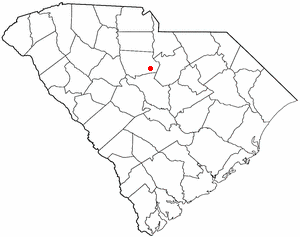
Ridgeway is a town in Fairfield County, South Carolina, United States. The population was 319 at the 2010 census. It is part of the Columbia, South Carolina Metropolitan Statistical Area.

Winnsboro is a town in Fairfield County, South Carolina, United States. The population was 3,550 at the 2010 census. The population was 3,215 at the 2020 census. A population decrease of approximately 9.5% for the same 10 year period. It is the county seat of Fairfield County. Winnsboro is part of the Columbia, South Carolina metropolitan area.

St. Stephen's Episcopal Church is an historic Episcopal church building located northeast of Ridgeway, South Carolina, on County Road 106. Built of wood in 1854 in the Carpenter Gothic style, it was designed by the Rev. John Dewitt McCollough, who later became its rector. The exterior was painted a maroon color. In 1920, its exterior wood was covered by brick veneer, so that it appears today as a brick Gothic Revival style building on the outside while the interior retains its Carpenter Gothic features. A wing was added in the 1940s to create space for a parish hall and Sunday school.

Mount Olivet Presbyterian Church is a historic Presbyterian church located near Winnsboro, Fairfield County, South Carolina. It was built in 1869, and is a one-story, rectangular, front-gabled stuccoed brick building. The stucco is scored to resemble cut stone and the church sits on a granite foundation. The large cemetery northwest of the church contains several historically and artistically significant gravestones dating back to 1795 and is enclosed by a cast-iron fence.

New Hope A.R.P. Church and Session House is a historic Associate Reformed Presbyterian Church building and Session House located near Winnsboro, Fairfield County, South Carolina. They were built about 1886. The meeting house form church is a one-story, weatherboarded, frame church. It features a bracketed belfry with a bellcast roof. The session house is a 10 by 12 foot weatherboarded frame building with a gable roof.
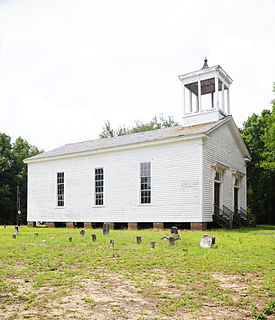
Ruff's Chapel is a historic Methodist chapel at U.S. 21 and SC 34 in Ridgeway, Fairfield County, South Carolina. It was built about 1870, and is a single-story, rectangular frame building, sheathed in weatherboard, with a front gabled roof. It has a square open belfry with a metal covered bellcast hip roof and a ball finial.

Tocaland is a historic plantation house located on S.C. Route 344 near Winnsboro, Fairfield County, South Carolina. It was built about 1854, and is a 1+1⁄2-story, weatherboarded frame Greek revival style dwelling on a raised basement. The front facade features four 8-foot high stuccoed granite piers that support a pedimented front porch. The porch is supported by four paneled wooden pillars, pilasters, and has a plain balustrade.
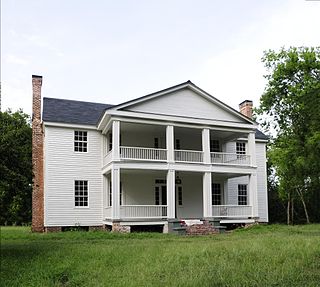
Dr. John Glenn House is a historic home located near Jenkinsville, Fairfield County, South Carolina. It was built about 1845, and is a two-story, five bay, weatherboarded frame, end-gabled Greek Revival style residence. It has a double-pile and central-hall plan with a rear shed room. The front façade features a two-tiered porch in the three central bays with a pedimented gable end.

High Point is a historic home located near Jenkinsville, Fairfield County, South Carolina. The original section was built about 1800, and is a two-story, five bay, frame farmhouse with later expansions. A two-story rear ell was built about 1870. It features a one-story, shed-roofed porch across the front façade supported by square posts. Also on the property are the contributing family cemetery, a frame smoke house, and a frame barn.

Kincaid-Anderson House, also known as Fairfield, is a historic home located near Jenkinsville, Fairfield County, South Carolina. It was built about 1774, and is a two-story, brick Georgian style dwelling. It has a hipped roof and sits on a fieldstone foundation. It has small brick side wings that were added in a 1920s restoration. Also on the property is a two-story brick and frame work house that has been converted into a guesthouse. It was the home of James Kincaid, who was one of the first purchasers of cotton in the South Carolina upcountry and was possibly involved in the early development of a cotton gin.

Blink Bonnie, also known as Robertson House, is a historic plantation house located near Ridgeway, Fairfield County, South Carolina. It was built in 1822, and is a 1-½ story clapboard frame house on a brick foundation. It features a one-story, hipped roof front porch supported by six double capped square columns. The house has a one-story addition and an old two-room brick kitchen with large open fireplaces, ovens and warmers.
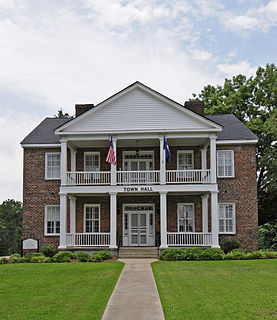
Century House, also known as Brick House and Beauregard's Headquarters, is a historic plantation house located near Ridgeway, Fairfield County, South Carolina. It was built about 1853, and is a large, two-story brick house in the Greek Revival style. It features double-tiered, balustraded piazzas. During the American Civil War, Century House entertained and sheltered many refugees from Low Country South Carolina and Georgia and also served as the headquarters for General P. G. T. Beauregard and his staff when Columbia was evacuated upon the approach of Gen. William Tecumseh Sherman’s Army in 1865.
Hunter House is a historic home located near Ridgeway, Fairfield County, South Carolina. It was built about 1820, and is a 1+1⁄2-story, "L"-shaped Federal style weatherboarded building on a raised brick basement. It has a gable roof and exterior end chimneys. The five-bay façade features a pedimented porch sheltering the three central bays.

Valencia is a historic plantation house located near Ridgeway, Fairfield County, South Carolina. It was built in 1834, and is a large two-story frame house on a brick pier foundation. The house features a hipped roof, two mammoth chimneys, and a broad one-story piazza with unique elliptical arches. Valencia was built by Edward Gendron Palmer, a leader in civic, political, and religious life of Ridgeway and Fairfield County.
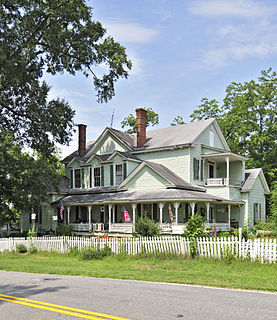
Monroe Wilson House is a historic home located at Ridgeway, Fairfield County, South Carolina. It was built about 1890, and is a two-story, rectangular, frame Victorian vernacular house. It features a porch that runs along the façade and southeast elevation with square posts and elaborate brackets. There is a small second story porch over the front entrance.

Old Stone House is a historic home located near Winnsboro, Fairfield County, South Carolina. It was built in 1784, and is a two-story, side-gable roofed, stone building, with a double-pile floor plan and stone end chimneys. The façade has a central door with a massive stone lintel flanked by single four-over-four windows with stone lintels. It was built by Samuel Gladney and in 1870 it was purchased by the Lebanon Presbyterian Church for use as a parsonage.
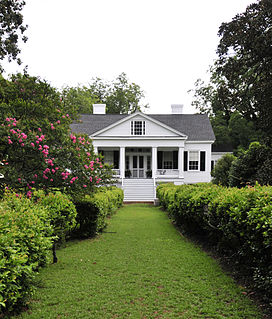
Rural Point, also known as Robertson House and Doty House, is a historic home and garden located at Winnsboro, Fairfield County, South Carolina. It was built in 1852, and is a 1+1⁄2-story, 12 bay, Greek Revival style frame dwelling over a high basement. The façade features a gable-roofed porch which is supported by four square columns. The property features a semi-formal garden said to have been designed by John Grimke Drayton, noted landscape architect of Magnolia Gardens in Charleston, South Carolina. Also on the property is a typical southern planter's office of white clapboard. It was built by William Ross Robertson, probate judge and commissioner of equity of Fairfield County who served in South Carolina House of Representatives and as a member of the Secession Convention.
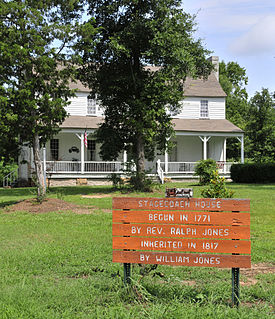
Vaughn's Stage Coach Stop is a historic stagecoach stop located near Ridgeway, Fairfield County, South Carolina. It was built about 1820, and is a two-story, weatherboarded frame, gable-roofed residence with a double-pile and central hall floor plan. The building sits on a foundation of stone piers, has end chimneys, rear shed rooms, and a left rear addition. The façade features a one-story, shed-roofed porch with a plain wooden balustrade supported by six slender wooden posts.

Ridgeway Historic District is a national historic district located at Ridgeway, Fairfield County, South Carolina. The district encompasses 31 contributing buildings in the town of Ridgeway. A majority of the buildings in the district were built between 1890 and 1915, the heyday of cotton production in the area. The district includes a commercial block with a predominance of simply ornamented two-story brick stores and a residential block with primarily asymmetrical, frame, weatherboarded houses lining the tree shaded streets. Styles include Queen Anne, Neo-Classical, Victorian, and Bungalow. Notable buildings include the J. Spann Edmunds House, Augustus Talley Moore House, Thomas Co. Store, Ruff Furniture Store, Dobson's Drug Store, Ridgeway Town Hall, Ruff's Gin Shop, James Team's Drugstore, and the Charlotte and South Carolina Railroad House.



















